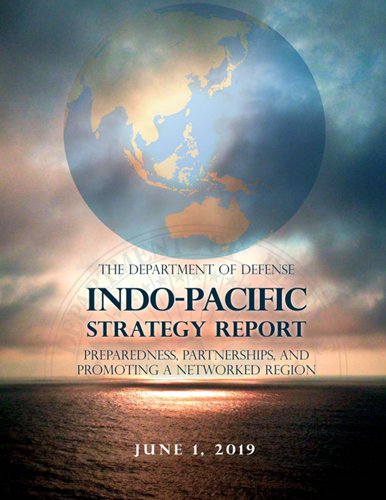HOME >> OPINION
US Indo-Pacific Strategy: hard to achieve goals
By Wang Yinghui Source:Global Times Published: 2019/6/26 18:53:40
Indo-Pacific Strategy wobbles as stakeholders see through US motives

The photo is the cover of the Indo-Pacific Strategy Report published on the official website of the US Department of Defense.
The 34th ASEAN Summit has just concluded, with the approval of a prominent product of the Outlook on the Indo-Pacific. This ASEAN version of the Indo-Pacific concept stresses ASEAN's centrality and the contribution of all regional countries to a peaceful and prosperous Indo-Pacific. The move can be seen as a subtle rebuttal of the US Indo-Pacific Strategy.
On June 1, the US Department of Defense released the Indo-Pacific Strategy Report, two years after President Donald Trump first proposed the concept. In line with the previous National Security Strategy and National Defense Strategy, the report reiterates the major power competition and focuses on China and Russia as competitors. However, the 78-page report, with its hostile stance, empty words and insufficient concrete measures, outlines goals that are hard to achieve.
First and foremost, the intention of the report is self-contradictory. At the very beginning, it points to a "free and open Indo-Pacific" for all, but excludes China, Russia and North Korea, calling them "revisionist, malign and rogue" respectively. Actually, it again stresses the China and Russia threats as destructive factors in regional stability without any reliable evidence.
For example, it criticizes China's "militarization" and "grey zone" activities in the South China Sea, but does not touch on the increasingly threatening military deployment of the US in the region, such as the frequent so-called freedom of navigation operations and joint exercises.
And the approaches the US proposes for a regional solution are also self-contradictory. It stresses three lines of efforts, namely preparedness, partnership and networked region, for strengthening a forceful posture and sustaining US influence in the region.
By preparedness, the US means to strengthen current presence in the Indo-Pacific by having more access, more joint exercises and more investment in advanced weaponry in the region. The whole report stresses an "open and free," peaceful and stable region, but emphasizes military means, by conducting more than 90 joint exercises in the region every year. A greater degree of military deployment in the region will only lead to more tensions, as we have seen in the deterioration of the situation in the South China Sea in the past few years.
And by partnership and a networked region, the US plans to strengthen defense relations with its allies and partners and engage more in regional organizations, with the aim of expanding the relationship into trilateral and multilateral frameworks. The report lists all the regional countries, even smaller Pacific island countries, with the exclusion of China, Russia and North Korea. The US intention is crystal clear, which is to rally with all its allies and partners and make new friends to form networks to contain these three countries.
However, countries in the region do not see eye to eye with the US. Every country wants peace and growth, and they know from experience that by taking the side of one major country against another is not in their interests. Besides, most countries in the region have joined the China-proposed Belt and Road Initiative and have seen positive results.
Even in the case of India, which is seen as one "pivot" of the strategy, New Delhi emphasizes that Indo-Pacific is only a geographical term. So far, India has maintained an unenthusiastic attitude toward the strategy and is not actively working with the US to contain China.
Southeast Asian countries are also very skeptical of the US strategy. Though the US has repeated that ASEAN has a central role in the strategy, the group has neither endorsed nor rejected the US version of the Indo-Pacific Strategy.
ASEAN member states have held rounds of consultations on forging a regional consensus on this new concept. The concern that ASEAN might be bypassed and its centrality undermined was at the forefront. Besides, ASEAN countries enjoy robust trade ties with China, thus do not want to take sides.
Even the closest partners of the US - Australia and Japan - find it hard to follow Washington step by step. Trump has been pressuring US allies to shoulder more "burden-sharing" by increasing their defense spending, which has aroused opposition and resistance from allies. Moreover, both Canberra and Tokyo find it hard to totally turn their backs on China, considering their deep interdependence on trade and economy.
Finally, the report does not give concrete plans and practical policies for implementing the strategy. It only lists all the defense cooperation that has been done in previous years, much of which initiated by the Obama administration, like the Southeast Asian Maritime Security Initiative. Therefore, there are words like "cooperation and coordination" everywhere in the report, but very few plans.
In the end, to advance the strategy, it is definitely wrong to create adversaries and bring together allies and partners to contain them. China is a major country in the Asia-Pacific region. If the US really wants peace, stability and prosperity in the region, it should seek to cooperate with every country in the region, including China.
The author is an associate professor at the National Security College of National Defense University. opinion@globaltimes.com.cn
Newspaper headline: Indo-Pacific Strategy wobbles as stakeholders see through US motives
RELATED ARTICLES:
Posted in: VIEWPOINT